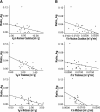The impact of dopamine on aggression: an [18F]-FDOPA PET Study in healthy males
- PMID: 24155295
- PMCID: PMC6618436
- DOI: 10.1523/JNEUROSCI.1398-13.2013
The impact of dopamine on aggression: an [18F]-FDOPA PET Study in healthy males
Erratum in
-
Correction: Schlüter et al., The Impact of Dopamine on Aggression: An [18F]-FDOPA PET Study in Healthy Males.J Neurosci. 2018 Jan 17;38(3):765. doi: 10.1523/JNEUROSCI.3540-17.2017. J Neurosci. 2018. PMID: 31329683 Free PMC article.
Abstract
Cerebral dopamine (DA) transmission is thought to be an important modulator for the development and occurrence of aggressive behavior. However, the link between aggression and DA transmission in humans has not been investigated using molecular imaging and standardized behavioral tasks. We investigated aggression as a function of DA transmission in a group of (N = 21) healthy male volunteers undergoing 6-[18F]-fluoro-L-DOPA (FDOPA)-positron emission tomography (PET) and a modified version of the Point Subtraction Aggression Paradigm (PSAP). This task measures aggressive behavior during a monetary reward-related paradigm, where a putative adversary habitually tries to cheat. The participant can react in three ways (i.e., money substraction of the putative opponent [aggressive punishment], pressing a defense button, or continuing his money-making behavior). FDOPA-PET was analyzed using a steady-state model yielding estimates of the DA-synthesis capacity (K), the turnover of tracer DA formed in living brain (kloss), and the tracer distribution volume (Vd), which is an index of DA storage capacity. Significant negative correlations between PSAP aggressive responses and the DA-synthesis capacity were present in several regions, most prominently in the midbrain (r = -0.640; p = 0.002). Lower degrees of aggressive responses were associated with higher DA storage capacity in the striatum and midbrain. Additionally, there was a significant positive correlation between the investment into monetary incentive responses on the PSAP and DA-synthesis capacity, notably in the midbrain (r = +0.618, p = 0.003). The results suggest that individuals with low DA transmission capacity are more vulnerable to reactive/impulsive aggression in response to provocation.
Figures

Similar articles
-
Net influx of plasma 6-[18F]fluoro-L-DOPA (FDOPA) to the ventral striatum correlates with prefrontal processing of affective stimuli.Eur J Neurosci. 2006 Jul;24(1):305-13. doi: 10.1111/j.1460-9568.2006.04903.x. Eur J Neurosci. 2006. PMID: 16882026
-
'Prefrontal' cognitive performance of healthy subjects positively correlates with cerebral FDOPA influx: an exploratory [18F]-fluoro-L-DOPA-PET investigation.Hum Brain Mapp. 2007 Oct;28(10):931-9. doi: 10.1002/hbm.20325. Hum Brain Mapp. 2007. PMID: 17133402 Free PMC article.
-
Lower dopamine tone in the striatum is associated with higher body mass index.Eur Neuropsychopharmacol. 2018 Jun;28(6):719-731. doi: 10.1016/j.euroneuro.2018.03.009. Epub 2018 Apr 26. Eur Neuropsychopharmacol. 2018. PMID: 29705023
-
Effects of Smoking Cessation on Presynaptic Dopamine Function of Addicted Male Smokers.Biol Psychiatry. 2016 Aug 1;80(3):198-206. doi: 10.1016/j.biopsych.2015.11.009. Epub 2015 Dec 1. Biol Psychiatry. 2016. PMID: 26803340
-
PET studies of cerebral levodopa metabolism: a review of clinical findings and modeling approaches.Neuroscientist. 2009 Dec;15(6):635-50. doi: 10.1177/1073858409338217. Neuroscientist. 2009. PMID: 19793723 Review.
Cited by
-
The influence of the COMT Val158Met polymorphism on prefrontal TDCS effects on aggression.Sci Rep. 2024 Feb 10;14(1):3437. doi: 10.1038/s41598-024-53930-3. Sci Rep. 2024. PMID: 38341445 Free PMC article. Clinical Trial.
-
Impact of non-uniform attenuation correction in a dynamic [18F]-FDOPA brain PET/MRI study.EJNMMI Res. 2019 Aug 19;9(1):77. doi: 10.1186/s13550-019-0547-0. EJNMMI Res. 2019. PMID: 31428975 Free PMC article.
-
Perspective: Gestational Tryptophan Fluctuation Altering Neuroembryogenesis and Psychosocial Development.Cells. 2022 Apr 8;11(8):1270. doi: 10.3390/cells11081270. Cells. 2022. PMID: 35455949 Free PMC article.
-
A Positive Affective Neuroendocrinology Approach to Reward and Behavioral Dysregulation.Front Psychiatry. 2015 Jul 2;6:93. doi: 10.3389/fpsyt.2015.00093. eCollection 2015. Front Psychiatry. 2015. PMID: 26191007 Free PMC article. Review.
-
Reward vs. Retaliation-the Role of the Mesocorticolimbic Salience Network in Human Reactive Aggression.Front Behav Neurosci. 2016 Sep 27;10:179. doi: 10.3389/fnbeh.2016.00179. eCollection 2016. Front Behav Neurosci. 2016. PMID: 27729852 Free PMC article.
References
-
- Berkowitz L. Pain and aggression: some findings and implications. Motiv Emot. 1993;17:277–293. doi: 10.1007/BF00992223. - DOI
Publication types
MeSH terms
Substances
LinkOut - more resources
Full Text Sources
Other Literature Sources
Miscellaneous
